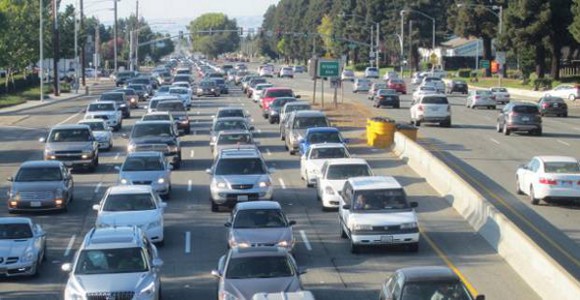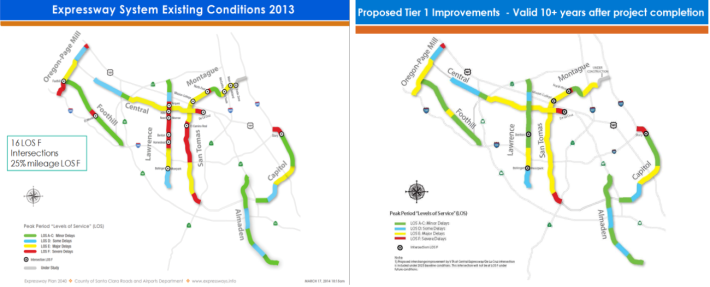VTA Measure B’s Bloated Highway Expansions Leave Transit Unfunded
4:18 PM PDT on October 25, 2016

The Valley Transportation Authority (VTA)'s proposed 30-year Measure B half-cent sales tax is bloated with billions of dollars in highway traffic expansions. If Santa Clara County voters pass Measure B on November 8, $1.85 billion would be lavished on highway projects while less than half that amount would go to bus, light rail, bicycling, and walking improvements combined over the next 30 years.
"We have no intention of leaving them stranded at the curb," said Silicon Valley Leadership Group President and CEO Carl Guardino of "non-choice" VTA riders who don't own a car, during a debate Wednesday afternoon on Measure B at De Anza College's Student Senate. "That's why half of a billion dollars is for lifeline service and core transit service to meet their needs."
While $500 million for better bus and light rail service might sound like a lot, that's the amount Measure B would invest over 30 years, and it's just 8 percent of total revenues. This is only half the investment needed only to restore bus service to 2001 levels [PDF]. Just $250 million over 30 years, or 4 percent of revenues, would go into fixing hazards faced by people walking and bicycling.
"To repair our roads and relieve congestion, Yes on Measure B," proclaims a video ad on the Countywide Coalition To Fix Our Roads, Fill Potholes, And Relieve Traffic Congestion website. "Measure B improves highways 101, 280, 85, 17, and 87... Better roads, better commutes. Yes on Measure B."
But for VTA, "better roads" means increasing highway capacities for more traffic with new traffic lanes and underpasses, and rebuilding bigger interchanges, the same failed strategy that has led to today's worsening traffic jams.
Santa Clara County ballots promise voters that Measure B will "Relieve traffic on all nine expressways, key highway interchanges," while pursuing a long-failed strategy for doing so. Measure B includes funding for a list of 50 highway expansion projects [PDF], based on the outdated Auto Level of Service method that disregards trip reduction programs or transit improvements as feasible mitigations for reducing traffic congestion.
"We need to have a band-aid before our transit system can be completed," stated former Santa Clara County Supervisor Rod Diridon, Sr. to the Santa Clara City Council at an October 11 study session as a justification for Measure B's highway expansions. "We need to eliminate as many bottlenecks as possible so that our industry doesn't move away."

One clever way of winning support for VTA's bottleneck removal strategy of widening highways is to simply call them transit improvements. The agency's $350 million Measure B project to widen Highway 85 from six to eight lanes and install Express Lanes is described as "new transit and congestion relief projects" in the county's voter guide.
On top of sinking over one-fourth of Measure B revenues into highway expansions, VTA officials are still insisting on duplicating existing Caltrain and bus service by tunneling BART from Diridon Caltrain Station to Santa Clara Caltrain Station, after BART is extended from Fremont to San Jose.
"I will be adamant in my advocacy that we build all four stations from Alum Rock all the way to Santa Clara, or this BART project will not be a success," declared VTA Board of Directors member Sam Liccardo in June when the agency voted to place Measure B on county ballots.
Measure B's opponents, which include the Sierra Club and the Silicon Valley Taxpayers Association, point to such rigid support for highway expansions and wasteful transit projects such as BART from Diridon to Santa Clara as evidence that VTA is headed in the wrong direction. They say the agency needs to present a much more effective set of transportation investments than Measure B to voters for approval.
"We need a vision for transit in Santa Clara Valley that serves future needs," said Andy Chow, President of Bay Rail Alliance which opposes the tax measure. "This is for 30 years. Why not put up a credible plan with more equitable funding for social justice and environmental protection?"
Check out Streetsblog's coverage of Measure RR/The BART bond, San Francisco Measures J & K and Prop. E, Oakland's Measure KK, and Contra Costa's Measure X.
Stay in touch
Sign up for our free newsletter
More from Streetsblog San Francisco
Commentary: There is Zero Ambiguity to the West Portal Tragedy
What happened in West Portal was entirely predictable and preventable. The city must now close Ulloa to through traffic and make sure it can never happen again
Independent Safety Advocates Beef up the Wiggle
Signs and soft-hit posts installed by advocates make the Wiggle bike route calmer and safer for cyclists and pedestrians




